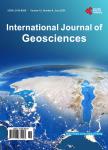Geophysical Study by Electrical Soundings of the Tartar Aquifer Unit, Boujdour Region, Morocco
Geophysical Study by Electrical Soundings of the Tartar Aquifer Unit, Boujdour Region, Morocco作者机构:Geodynamics Laboratory of Natural Resources (LGRN) Dhar Mahraz Faculty of Science Sidi Mohamed Ben Abdellah University Fez Morocco Geosciences Laboratory of Natural Resources (LGRN) Hydroinformatics Team Faculty of Science Ibn Tofail University Maamora Campus Kenitra Morocco AFRICA GEO-SERVICES Society Fez Morocco Sakia El Hamra and Oued Eddahab Hydraulic Basin Agency Laayoune Morocco
出 版 物:《International Journal of Geosciences》 (地球科学国际期刊(英文))
年 卷 期:2020年第11卷第3期
页 面:58-83页
学科分类:070801[理学-固体地球物理学] 07[理学] 0708[理学-地球物理学]
主 题:Tartar Aquifer Unit Vertical Electrical Soundings Resistivity
摘 要:The Tartar aquifer unit, is located at the SSO of the city of Boujdour, at a distance of nearly 86 km, and crossed (in its western part) by the National Road N1 connecting the towns of Boujdour and Lagouira passing through the vicinity of the city of Dakhla (PK40). It is exploited by rural settlements for domestic use (especially the inhabitants of fishing villages) and livestock watering, only through wells named Khtout Hobia (IRE 126/124) and Hassi Tartar known as Khtout Trayh (IRE 104/124). These wells have been tracked by a piezometric groundwater table and from 2011 to the present day. The interpretation of the electrical soundings in AB ≤ 2000 m allowed to differentiate the presence of two families of electrical soundings A and B, to establish the resistivity maps in AB = 200, 300 and 400 ihm⋅m with qualitative aspects, to draw up the map of the isohypses of the roof of the intermediate Dt1 representing the impermeable floor of the aquifer and to highlight two types of discontinuities;electrical discontinuities corresponding to lateral facies changes (limit of erosion surfaces) separating the families A and B of electrical soundings and those corresponding to syn-sedimentary faults which structured the formations into horsts and grabens. The lithological sections of the existing water points and that of oil well 43-1 allowed the geological identification of the geoelectric layers highlighted by the electrical soundings diagrams. As a result, the sandstone and lumachelic formations constituting the aquifer are of Moghrebian-Pleistocene age represented by the resistant R (Family A), sometimes grouping, in its basal part, sandstone levels of the Miocene roof (Family B). These formations lie directly on the Miocene sandy marls represented by the intermediate Dt1. For the present work, we will focus only on the transverse geoelectric cross-section TA, with an SW-NE orientation, which characterizes all the longitudinal sections established following the correla



